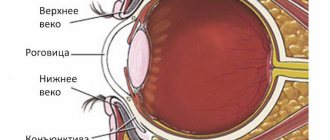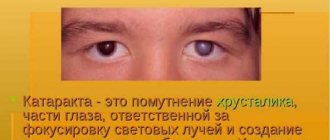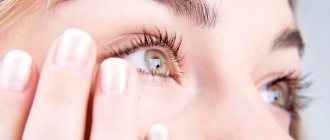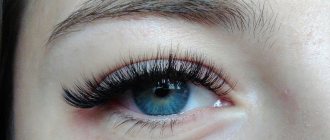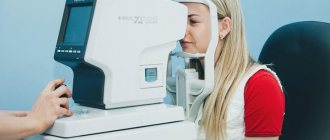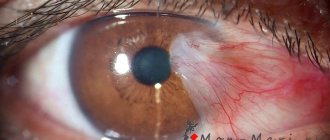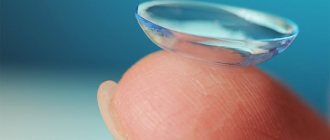Why does the top of my head hurt and put pressure on my eyes?
Headaches can be of different types. Accordingly, in order to relieve the pain symptom, various methods of therapy are necessary. In some cases, a walk in the fresh air or hot tea will help, and some types of pain can be harbingers of serious health problems. This includes pain in the upper part of the head while simultaneously feeling pressure on the eyes.
Diseases of the visual apparatus
During the initial consultation with complaints of bursting eye pain, the ophthalmologist tries to detect diseases according to his profile. Such symptoms occur in many eye pathologies, but among the most common diagnoses, the following listed causes lead.
Intraocular hypertension
With this disease, patients complain of aching in one or both eyes; it seems to them that the eyeball is bursting. Often all this is accompanied by complaints of headache. There are cases when intraocular hypertension is asymptomatic and is detected only after measuring intracranial pressure.
Hypertension can be essential or symptomatic. Essential affects people over 35 years of age. Symptomatic can occur as a result of intoxication with chemicals or as a side effect after certain medications; it often occurs against the background of existing vision pathology.
Intraocular hypertension, like glaucoma, is characterized by an increase in intracranial pressure with the difference that the optic nerve is not affected. However, it is dangerous because it can develop into secondary glaucoma with its inherent symptoms.
Mechanical damage to the eye
Minor types of injuries, such as shallow penetration of foreign bodies, are not dangerous. If you apply in a timely manner, everything will go away within a week. A much greater threat to the eyes is posed by moderate mechanical damage caused by a blunt or sharp object.
| After the injury, there is a feeling of something pressing forcefully on the eyes from the inside, the reasons lie in internal hemorrhage. |
In this case, the conjunctiva, eyeball, and eyelid may be injured, as well as the lens, retina, and iris. Why is this dangerous? With mechanical trauma, internal hemorrhages are possible, and in addition, infection of the injured tissues. A timely visit to a doctor will allow you to accurately determine all the damage and also save the patient from complications. The sooner measures are taken, the greater the chances of a quick recovery!
Swelling of the eyes or swelling of the eyelids with pain
When an ophthalmologist is contacted with a complaint that the eyes are swollen, they mean that the eyelids are inflamed and swollen. This happens for many reasons. According to certain characteristics, three are distinguished:
- Allergic edema. They appear violently, suddenly, and mostly the upper eyelids swell, but without pain. To eliminate it, it is necessary to identify the allergen that caused the swelling. Antihistamines are prescribed as therapy.
- Inflammatory swelling. They are distinguished by redness of the eyelid, when you touch it, you feel an increased temperature, and when you press it, pain is possible. They occur with infectious eye diseases; it is in these cases that the eyes hurt, as if they are being pressed.
- Non-inflammatory swelling. They are symptoms of heart and kidney diseases. In these cases, the eyelids swell in the morning, and the swelling disappears during the day.
Eye inflammation: conjunctivitis
| This disease is characterized by tearing, redness of the eyes and pain. This occurs due to inflammation of the conjunctiva, the thin film that covers the outer surface of the eyeball. |
The disease is easily treatable and its symptoms disappear within two weeks. If a patient with conjunctivitis suffers from severe eye pain or photophobia, treatment takes longer.
Conjunctivitis can be infectious, allergic, or occur due to injury. The greatest danger is the so-called neonatal conjunctivitis, which affects newborns. Infection is possible when passing through the birth canal if the woman in labor is sick with chlamydia or gonorrhea.
Symptom of "pressure in the eyes"
Often, patient complaints of distension in the eyeball, pain and discomfort are not associated with increased intraocular pressure.
This condition is often observed with neurological diseases (migraines), increased blood pressure (hypertensive crisis) or, conversely, its decrease (vegetative-vascular dystonia of the hypotonic type), with general inflammatory diseases (FLU, ARVI) or other eye diseases.
Office workers who spend all day in front of the computer are frequent patients of the ophthalmologist who complain of a feeling of pressure in the eyes. This is due to visual fatigue and dry eyes (the so-called “Computer Vision Syndrome”).
Treatment with folk remedies
You can bring eye pressure back to normal using traditional medicine. To do this, make a decoction of clover and take 100 grams daily at night. Another effective popular tip is eye lotions. Pour two glasses of boiling water over 2 tablespoons of lily of the valley flowers and a glass of nettle.
Leave overnight, then add a spoonful of baking soda. The lotions are ready. Wash your eyes daily with aloe vera decoction. First, chop 4 aloe leaves, pour boiling water and leave for 5-10 minutes. Wash your eyes with the resulting solution 5 times a day.
Surely you will be interested to know which foods reduce eye pressure. Kefir with cinnamon has a good effect, which doctors advise drinking in the evening before bed.
For a human body prone to high eye pressure, the intake of omega-3 polyunsaturated fatty acids is of paramount importance.
Antioxidants are extremely useful, which are present in large quantities in green cabbage: spinach, broccoli, kale and Brussels sprouts. The yolk of a raw egg is considered beneficial in this regard. Be sure to eat dark forest berries: blueberries, blackberries and blueberries.
Now we’ll tell you which foods increase eye pressure. It is necessary to avoid foods that stimulate a sharp release of insulin. These are potatoes, cereals, pasta and almost all types of sweet and starchy foods. Not all fats are healthy for humans.
The use of tea leaves is popular as a preventive method. It cleanses the eyes well. For the procedure, take a cotton pad and soak it in fresh tea leaves. It improves vision, and the image becomes clear, blurriness disappears.
It is effective to use a decoction of chamomile, which can be purchased at a pharmacy. To prepare it you should take 3 tbsp. l. herbs, pour 1 cup of boiling water, put on low heat for 10 minutes. After the time has passed, cool, strain, moisten a cotton pad and wipe your eyes.
It is useful to use various herbal infusions in treatment. Lily of the valley flowers in combination with nettle have proven themselves well. You should take 1 tsp. first component and add it to half a glass of the second, mix, pour the entire mixture into a small container and pour 300 ml of water at room temperature.
Leave for 9 hours in a cool, dark place. After time, add ½ tsp to the mixture. baking soda. Then you need to take a cotton pad, moisten it and apply it to your eyes at least 2 times a day.
Another effective method is treatment with hawthorn and yarrow. To prepare the decoction, you need to take both herbs in equal quantities, pour 500 ml of boiling water, and put on low heat for 10-15 minutes. Then leave the broth for 1 hour, strain and drink 1 glass 3 times a day.
Treatment with aloe is popular for glaucoma. To do this, take 1 leaf, chop it, pour 250 ml of boiling water over the resulting pulp, leave for 3 hours, then strain and rinse your eyes with the product at least 3 times a day.
Eye clinics
- Voronezh
- Ekaterinburg
- Izhevsk
- Kazan
- Krasnodar
- Moscow
- Nizhny Novgorod
- Novosibirsk
- Permian
- Rostov-on-Don
- Samara
- Saint Petersburg
- Ufa
- Chelyabinsk
Heaviness in the eyes - they close themselves
Heaviness in the eyes is an unpleasant symptom that significantly worsens life.
This symptom prevents you from performing your daily work efficiently.
If symptoms reappear, you should consult a doctor. The severity may be a consequence of a serious ophthalmic disease.
Overwork
Heaviness in the eyes and head is a sign of visual fatigue. Asthenopia is a common problem among office workers, jewelers, welders and gas cutters.
Drowsiness
Inadequate rest leads to the appearance of this symptom. Lack of sleep, getting up early and going to bed late have a negative impact not only on your overall health.
The lack of sleep is visible in the eyes; you constantly want to close them. Drowsiness leads to headaches and red eyes.
Exposure to ultraviolet radiation
Prolonged exposure to the sun causes dehydration. If a person does not drink enough water, the face, arms and legs begin to swell.
Wrong choice of contact vision correction means
Heaviness in the eyes can develop due to incorrectly selected optical power. Because of this, the eyes get tired faster, because vision is not clear enough and the visual analyzer has to strain a lot to examine objects at a certain distance.
Stress
When the body is under stress, changes occur in all organs and systems. Scientists are sure that the eyes send the first danger signals.
Stress manifests itself in lack of sleep and insomnia. They affect the visual organs, causing drowsiness. Heaviness is felt in the eyes and head. The person becomes nervous and irritable.
Blepharospasm
The cause of the disease still remains unknown; scientists are conducting research to identify the etiology and approach to therapy. A symptom of blepharospasm is spontaneous blinking.
The eyelids close on their own, the eye twitches. More often the disease affects both visual organs.
Myasthenia gravis
This disease is an autoimmune condition. The root cause of the pathology is considered to be a violation of neuromuscular transmission.
More often, myasthenia gravis affects the eyes, they literally close, the upper eyelid is heavy. Leads to squint.
Migraine
There is an ocular form of the pathology. It is characterized by loss of fields of visual perception. Pressing pain
It is important to exclude the causes of pain in the eye itself. After treatment, vision is restored and seizures stop. Relapses are possible
Other pathological causes
There is a large number of pathological conditions that can lead to heaviness in the eyes. The symptom is not always present all the time.
Other reasons that can lead to this symptom:
- mental illnesses;
- allergic conditions;
- acute stage of glaucoma;
- brain injuries;
- benign or malignant tumors in the head;
- atherosclerosis;
- glaucoma;
- sinus inflammation;
- age-related changes in the eyes.
Damage to the trigeminal nerve also causes an increasing sensation of pressure in the visual analyzer and pain when moving. This leads to a decrease in the acuity of visual perception and is extremely dangerous.
This is not the entire list of diseases that can lead to the appearance of this symptom. Severity occurs with renal and hepatic pathologies, as well as with pathologies of the endocrine system. Most ailments of an infectious and inflammatory nature appear before the eyes, even if they are not directly related to them.
Symptoms
Eye pathologies have many of the same symptoms. Along with the severity, patients complain of cephalgia and migraine, increased body temperature, burning and hyperemia of the mucous membrane.
Some pathologies are characterized by purulent or mucous discharge and increased lacrimation in the eyes. Sometimes accompanied by double vision and a burning sensation.
Traditional methods
Traditional methods are used both in the fight against diseases and heaviness in the eyes. They can be used if the disease is non-infectious.
Home methods include potatoes, apples, cucumbers, carrots and any other hard vegetable or fruit. Keep it in the refrigerator or place it in the freezer for a couple of minutes, cut off a circle and apply it to your eyelids. Do not hold it for a long time to avoid hypothermia. Two minutes is enough to get a boost of energy and relieve swelling.
Compresses are useful. Gauze or a cotton pad is moistened in the medicinal infusion and applied to the eyes for 15 minutes. Decoctions are prepared from parsley, chamomile, string, and linden. Cool milk will also work.
Diagnosis and treatment of pain in the vertex
Regardless of the cause of pain, therapy will include initial relief of pain symptoms, and then further individual treatment, depending on the characteristics of the patient’s body.
Diagnostics may include:
- ECG of the heart, blood pressure measurement;
- examination by a therapist, traumatologist, neurologist, ophthalmologist;
- general blood and urine analysis;
- radiography of the spine, especially the cervical spine;
- MRI and CT of the brain.
Important! Only after diagnosis and a collected medical history does the doctor prescribe therapy, which may include a combination of several treatment methods.
Make an appointment with a doctor using the link.
Drug therapy:
- Drugs that relieve spasms (Ibuprofen, Naproxen, Tempalgin).
- Sedatives containing triptans (Sumatriptan, Rizatriptan) and antidepressants.
- A course of vitamins and minerals.
- Botox procedures to relieve intramuscular spasm.
Physiotherapeutic treatment methods:
- Acupuncture, massage.
- Manual therapy.
- Hot water procedures.
Acupuncture helps relieve headaches
Traditional methods of treating headaches:
- Cold compresses on the headache area.
- When pressing on the temples up to 5 times, spasms can reduce their intensity.
- Herbal decoctions of lavender, sage, mint, chamomile, valerian.
- Psychotherapy if pain is associated with stressful situations.
- Relaxation activities: aromatherapy, yoga, meditation.
Important! Before any treatment, it is necessary to undergo diagnostics and consultation with a specialist. Self-prescribed therapy can lead to negative consequences if you are not familiar with the combination of drugs and their possible side effects that you may experience.
Preventive measures
| Most often, people who have close daily contact with a computer suffer from asthenopia. This segment of society should take preventive measures for asthenopia every day. |
When working with a monitor, it is recommended to look away and blink; concentrated vision for a long time provokes fatigue and redness of the eyes. When blinking, the necessary lubricant is released, which eliminates the dryness of the eyelid.
It is better to adjust the brightness of the computer monitor so that it is not contrasty, the picture is more faded and does not require much eye strain. The room should have daylight, a well-equipped workplace, and proper and comfortable seating.
It is also important to spend more time outside, follow a daily routine, and get enough sleep. It is better to include in your diet foods that contain vitamins for the eyes, such as broccoli, beets, blueberries, spinach, sprouted wheat and others
For prevention, you can also use a vitamin complex for the eyes, for example, Blueberry Forte. At home, it is recommended to perform exercises that allow the muscles of the eyelid to relax:
- rotation of the pupils forward and backward, right and left;
- performing the “eye figure eight” exercise;
- imaginary scanning with the gaze of a certain figure;
- circular rotation of the pupils of the eyes;
- switching vision from one object to another;
- exercises are recommended to be carried out not only at home, but also in the fresh air;
- One day a week you need to rest your eyes, exclude the computer and reading books, and replace them with a long walk in nature;
- warming up the neck with circular movements, as well as turning the head to the right and left;
- rubbing your palms and applying them to your eyes, changing the temperature relaxes tired eyelid muscles.
| The main prevention of asthenopia is regular visits to the ophthalmologist and a vision test. |
Preventing headache attacks
Prevention of a condition where the crown of the head and eyes hurts is to maintain a healthy lifestyle, which covers both exercise regimes and nutrition. Necessary:
- Ensure good, restful sleep in a well-ventilated area.
- Establish a water regime to eliminate dehydration.
- Balance the menu by enriching it with products containing B vitamins (nuts, eggs, spinach, etc.) or regularly take a course of vitamins.
- Reduce or completely eliminate the consumption of coffee, cigarettes, and alcohol.
- Play sports and increase the amount of time spent outside.
- Eliminate stressful situations and nervous tension as much as possible.
Watch a video from specialists about the types and causes of headaches:
Pathologies of other organs
Pressing eye pain may be present with headaches, acute respiratory viral infections, high blood pressure, vegetative-vascular dystonia, neuroses, and migraines. With an exacerbation of sinusitis or sinusitis, the patient experiences a headache that presses on the eyes. This occurs because the frontal and maxillary sinuses are located next to the eye socket.
With a migraine, the pain is localized in one place, usually the temple and eye socket. Dizziness, photophobia and nausea are added to it. Fever and constant headache, which radiates to the eyes, are observed with brain damage (encephalitis, meningitis). If these inflammatory processes are suspected, the patient is urgently hospitalized.
Why does the top of my head hurt?
Pain in the crown of the head can occur as a separate disease, but is also a symptom of many painful conditions. To identify the origin of pain, it is important to determine its nature and location as accurately as possible.
The causes of a pressing or sharp headache in the vertex area are varied and include mental and physical factors. The most common aching nature of the pain means the development of tension cephalgia, which occurs during stress, fatigue, and overexertion. Pain on the crown, neck or forehead can also accompany negative emotional states.
Due to today's busy lifestyle, headaches on the top of the head originate from the cervical spine. It is particularly concentrated at the back of the head, but can radiate to other areas of the head, particularly the crown. Discomfort is the result of a long stay in an uncomfortable position, stretching the neck muscles, and restricting blood circulation to the brain.
Pain on the crown (in the parietal part) of the head can also be caused by osteochondrosis of the neck, i.e. changes in the intervertebral discs, which are experienced especially by older people.
Identifying the source of pain is critical to treatment. Pressing and throbbing pain in the head, including on the top of the head, can occur at any time, at any age, regardless of gender.
Important! If the pain on the top of the head is sudden, prolonged, often changing in nature, and appears every day, you should consult a specialist.


